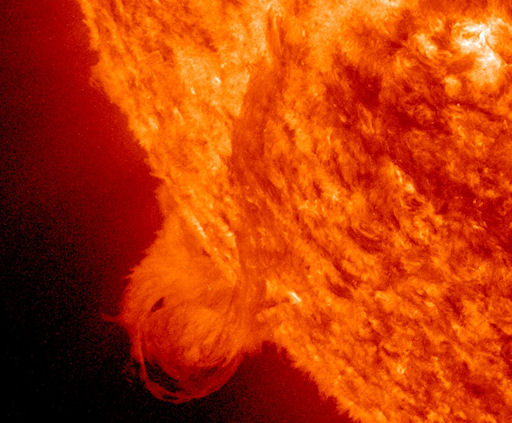Turn your cell phone into a field-tested satellite tracker. Works for Android and iPhone. | | |
THE MYSTERY OF VESTA: Is Vesta an ordinary asteroid or something much more interesting? Researchers are debating this question as NASA's Dawn spacecraft approaches the behemoth space rock for a closer look. Whatever Vesta turns out to be--a protoplanet, minor planet, or super-asteroid--you can own a piece. Authentic fragments of Vesta are on sale now in the Space Weather Store.
CRESCENT MOON ALERT: When the sun goes down tonight, step outside and look west. A crescent Moon of exquisite beauty is beaming through the twilight. Miguel Claro sends this preview from the Atlantic coast of Portugal near Lisbon:

"The crescent Moon on April 4th was only 1% illuminated," says Claro. "Nevertheless, I was able to see it over the bright lights of Costa da Caparica." The show continues tonight with an even easier-to-see 5% crescent. Don't miss it!
more images: from Marek Nikodem of Szubin, Poland; from Jim Werle of Las Vegas, Nevada; from Jim Saueressig II of Burlington, Kansas; from Alexandre Croisier of Brest, Brittany, France; from Stefano De Rosa of Turin (Italy); from Christophe Stolz of Köniz, Switzrland
UNSTABLE FILAMENT: An active filament of solar magnetism is snaking around the sun's southeastern limb today. Measuring more than 200,000 km along its sinuous backbone, the vast structure is in a constant state of motion. NASA's Solar Dynamics Observatory froze it in this snapshot taken 20:16 UT on April 5th:

Filaments as agitated as this one is often erupt and hurl parts of themselves into space. Because of the filament's location on the sun's limb, any such blast would not be Earth-directed, but it would be photogenic! Readers with solar telescopes are encouraged to monitor the action.
April 2011 Aurora Gallery
[previous Aprils: 2010, 2009, 2008, 2007, 2006, 2005, 2004, 2003, 2002]
Potentially Hazardous Asteroids (
PHAs) are space rocks larger than approximately 100m that can come closer to Earth than 0.05 AU. None of the known PHAs is on a collision course with our planet, although astronomers are finding
new ones all the time.
On April 5, 2011 there were 1215 potentially hazardous asteroids.
Notes: LD means "Lunar Distance." 1 LD = 384,401 km, the distance between Earth and the Moon. 1 LD also equals 0.00256 AU. MAG is the visual magnitude of the asteroid on the date of closest approach. | | The official U.S. government space weather bureau |
| | The first place to look for information about sundogs, pillars, rainbows and related phenomena. |
| | Researchers call it a "Hubble for the sun." SDO is the most advanced solar observatory ever. |
| | 3D views of the sun from NASA's Solar and Terrestrial Relations Observatory |
| | Realtime and archival images of the Sun from SOHO. |
| | from the NOAA Space Environment Center |
| | the underlying science of space weather |
| | for out-of-this-world printing and graphics |

